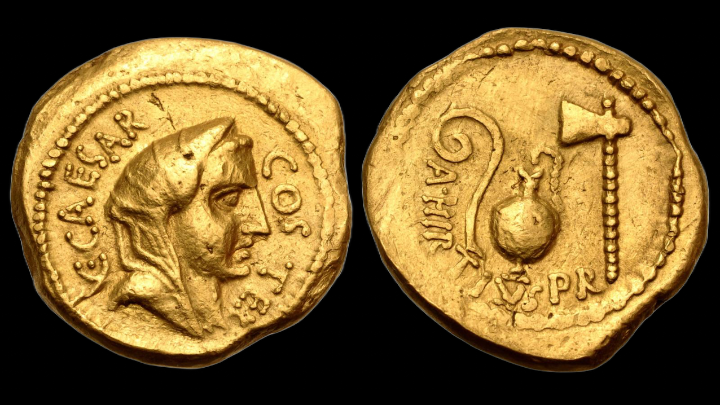Among the most prestigious coins of the Roman Republic, the aureus struck in 46 BC under the authority of Aulus Hirtius stands out for its rarity, crisp strike, and symbolic weight. Minted in Rome in the wake of Caesar’s victory at Thapsus, this aureus embodies the consolidation of his power and his drive for both religious and political legitimacy. For any discerning collector, it is a centerpiece—prized equally for its historical importance and its numismatic brilliance.
The Coin: an exceptional aureus, a reflection of Caesarian power
This gold aureus measures 18.5 mm in diameter and weighs 7.79 g. It was struck in Rome early in 46 BC under the supervision of Aulus Hirtius, then praetor and a close collaborator of Caesar.
On the obverse, a veiled head facing right appears, accompanied by the legend C·CAESAR·COS·TER, indicating that Caesar was serving his third consulship. The veiled figure is interpreted as either Vesta, goddess of the hearth, or Caesar himself in his role as Pontifex Maximus, thus highlighting his supreme religious authority.
The reverse depicts pontifical instruments—a lituus (augural staff), an aspergillum (sprinkler), a sacrificial axe, and a simpulum (ritual ladle)—accompanied by the legend A·HIRTIVS·PR, naming Aulus Hirtius as praetor. These symbols reinforce Caesar’s image as a religious leader and guardian of Roman tradition.
History : Julius Caesar, between conquests and absolute power
Born in 100 BC, he entered politics at a young age, opposing the dictator Sulla and aligning himself with his uncle by marriage, Marius. After steadily climbing the ranks of power, he became praetor in 62 and then consul in 59—the year he formed the famous First Triumvirate with Pompey and Crassus. Thanks to this alliance, he secured command over Gaul, where he led a brutal and victorious military campaign, marked by Gergovia, Alesia, and the fall of Vercingetorix.
But the balance of power shifted: Crassus died, and tensions with Pompey erupted. In 49 BC—the very year this denarius was struck—Caesar crossed the Rubicon, an open act of rebellion against the Senate that marked the beginning of a civil war. He eventually defeated Pompey at Pharsalus and crushed his remaining enemies at Thapsus and Munda.
Having become the most powerful man in Rome, Caesar concentrated power in his hands, fueling fear and jealousy. On the Ides of March in 44 BC, he was assassinated by his former allies, Brutus and Cassius.
A Testament
This aureus of Julius Caesar is far more than an ancient coin: it is a striking testament to a pivotal era in Roman history, symbolizing the transition from Republic to Empire. Its rarity, crisp strike, and rich iconography make it a prize piece for any passionate collector.
This aureus was sold at auction at CNG for $6,720.
If you’re looking for this coin, just ask—we’ll find it for you.
